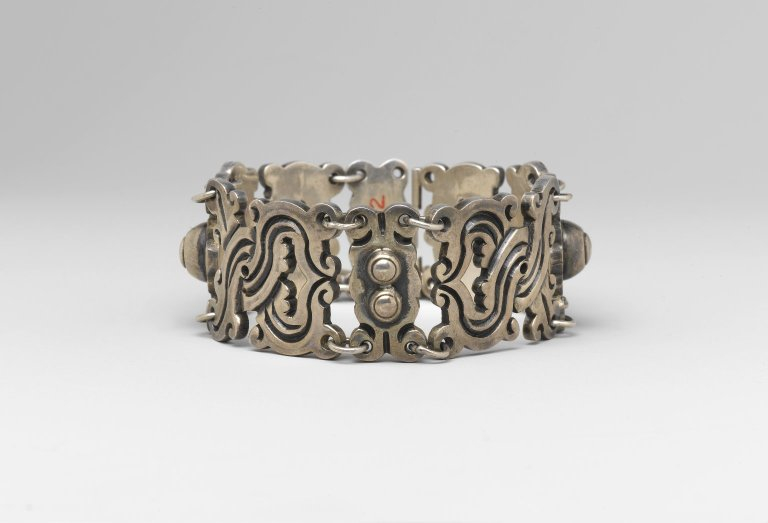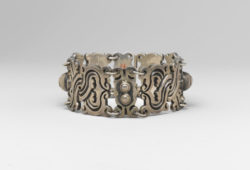William Spratling
William P. Spratling was part of a thriving artists colony in New Orleans in the 1920s. It was from New Orleans that Spratling first traveled to Mexico where he became a leading silversmith.

Courtesy of The Brooklyn Museum
Bracelet. Spratling, William Phillip (Artist)
The American architect and artist William Philip Spratling is known as the “Father of Mexican Silver.” By designing decorative objects based on Mexico’s traditional art forms, he created an industry that thrives to this day in the region surrounding Taxco, Mexico. Before moving to Taxco, a beautiful but impoverished Mexican village, Spratling had a successful academic career teaching architecture at Auburn University in Alabama. In 1921 he was hired to fill a similar position at Tulane University in New Orleans, where he became a leading figure in the city’s cultural renaissance of the 1920s.
Spratling was born September 22, 1900 in Sonyea, New York. When he was ten years old, his father, grieved by the deaths of his wife and a daughter, moved his remaining three children to his hometown of Auburn, Alabama. At age twelve Spratling was orphaned, and he was separated from his brother and sister, who were sent to live with various family members. In 1917 Spratling enrolled at Auburn University, and by the time he was a sophomore he was teaching classes in its department of architecture.
The New Orleans Years
In the 1920s the bohemian environment of the French Quarter, largely a Sicilian-immigrant slum and not yet teeming with tourists, attracted young artists, writers, and performers who found it a stimulating place to work. Although Spratling moved to the city to become an instructor at Tulane in the Uptown neighborhood, he was quickly drawn into the rich cultural ambience of the Vieux Carré, enjoying in particular friendships with members of its flourishing literary colony, including such notable writers as Sherwood Anderson and William Faulkner. Anderson often entertained friends at his apartment in the Lower Pontalba Building, giving Spratling the opportunity to meet celebrities such as poet Carl Sandburg, biographer Carl Van Doren, and novelist/artist John Dos Passos.
Spratling had several different apartments in the Quarter, including a second-floor studio overlooking the garden behind St. Louis Cathedral, where his neighbors included journalists Lyle Saxon and Roark Bradford, artists Caroline Durieux and Weeks Hall, and newspaper writer Natalie Scott. Living and working among such creative people resulted in a number of collaborations. With Scott, Spratling published an illustrated book about Louisiana plantations, and when William Faulkner shared his apartment for a time, they worked together to publish Sherwood Anderson and Other Famous Creoles, a series of caricatures of prominent French Quarter characters that was dedicated “To All the Artful and Crafty Ones of the French Quarter.
Much of Spratling’s social and professional activity in New Orleans was centered in the new Arts and Crafts Club of New Orleans on Royal Street. He taught a sculpting and clay modeling class there as well as a popular Saturday afternoon outdoor sketching class. When Spratling returned from his first trip to Mexico, he held an exhibit of pencil and watercolor sketches at the club. At its annual masquerade ball, Spratling was known for his imaginative costumes and performances at what was described as a fairly outrageous evening of entertainment.
The Mexican Years
In the winter of 1925, Frans Blom and Oliver La Farge, archeologists/anthropologists, arrived to teach at Tulane. In time they became close friends and mentors to Spratling, influencing the course of the rest of his life. They introduced him to pre-Columbian art and awoke in him a fascination with ancient Mesoamerican artistry and designs.
In 1926 Spratling made the first of several trips to Mexico, and in 1929 he decided to move to Taxco, a village seventy miles southwest of Mexico City surrounded by centuries-old silver mines. He quickly developed personal and professional friendships with Mexican artists such as Diego Rivera, Rufino Tamayo, and José Clemente Orozco. He even organized an exhibition of Rivera’s work at the Metropolitan Museum of Art in New York. In return, the painter wrote the introduction to Spratling’s book on Mexican village life titled Little Mexico.
Soon after his arrival in Taxco, Spratling was commissioned to draw plans for the home of Dwight Morrow, the US Ambassador to Mexico, in Cuernavaca. Morrow suggested to Spratling that Taxco’s silver could be used for making jewelry and other decorative objects. Hiring a goldsmith to create pieces based on his own designs, Spratling began what would eventually become a flourishing industry. His drawings, based on pre-Columbian motifs and other native art forms, appealed not only to the eye but also to a growing sense of Mexican nationalism. Their beauty was evidence that Mexican artists did not need to be bound by European forms.
Taller de las Delicias, Spratling’s workshop, soon attracted other craftsmen who expanded his designs to items made of copper, tin, leather, and textiles. Training novices in an apprentice system, he produced artisans who went on to open their own shops, many of them in the Taxco area, thereby transforming the village into a thriving arts and crafts center—and eventually a center of tourism. The program was so effective that, in 1946, the US Department of the Interior asked Spratling to develop a similar cottage-industry model for Alaska. It was never successfully implemented, however, partly due to insufficient funding. Yet Spratling became interested in Alaskan culture and began to incorporate its traditional motifs and forms into his design work.
Spratling’s business grew rapidly during World War II, as the United States could not import European goods. To meet the increased demand for his products, Spratling expanded his company by taking in private investors. By 1944 he had lost control of it, and he retired to a ranch he owned at Taxco-el-Viejo, where he spent his remaining years trying to rebuild his company, indulging his interest in archeology, and designing jewelry.
Spratling was killed in an automobile accident outside of Taxco on August 7, 1967. By then nearly 3,000 people were working in the silver business of Taxco. During his years there he had revitalized a town, restored a moribund industry, and generated new respect for the indigenous culture.
